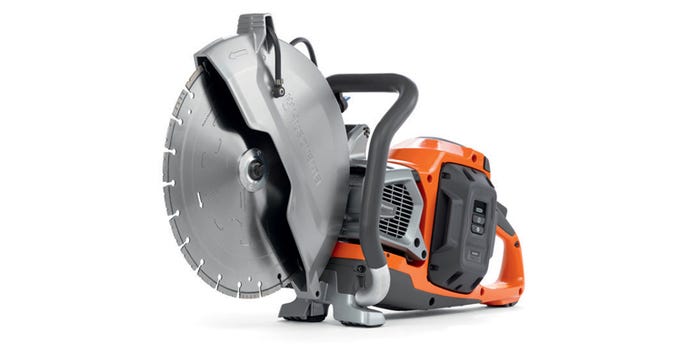As technologies continue to advance, the opportunities to use cordless tools for more and more concrete applications has expanded greatly. Here’s a look at the latest trends plus a sampling of new products.
February 24, 2022

At this year’s World of Concrete, you couldn’t help but notice an ongoing trend: cordless tools performing tasks that a few years ago would have been near impossible without a great deal of sacrifice in performance and ergonomics.
At Bosch’s outdoor exhibit, the manufacturer engaged attendees in a head-to-head battle of corded versus cordless. The two attendees each tried their hand with the cordless model, the Pro Factor GBH18V-45 1-7/8” SDS-max cordless rotary hammer; in the first face-off, the cordless model beat the corded model, and in the second face-off, they finished at the same time.
Husqvarna featured two technologies. It says the new PACE battery system, starting with the K1 PACE high-power battery cutter offers power and performance equivalent to gas-powered options. To its i-Series 36-volt platform, Husqvarna added the WT 15i water tank, the BV 30i screed, the DM 540i drill, and the DE 110i dust extractor.
One of the biggest roadblocks to cordless tools for intensive applications like concrete cutting has always been power-to-weight ratio. In order for batteries to pack enough power, they have to be larger, and there is only so much size and weight an operator can use. Using that much power could also drain the battery much faster, eliminating work efficiencies.
According to Lloyd von Scheliha, Husqvarna’s product market manager for power cutters, the advancements in cordless technology stem from both the batteries and the tools themselves. Battery cell developers have continued to refine and innovate to pack more power into smaller cells, just as we’ve seen with computers and smartphones. The result is more power without adding weight.
Simultaneously, tool manufacturers have been refining designs and motors to interact with the battery and to perform more efficiently. For example, Husqvarna designed its PACE cutter with a thinner core blade that reduces friction and puts less strain on the motor while using watts more productively, improving run time and performance.
“It’s about maximizing the efficiency of the battery platform and maximizing the productivity of the tool,” von Scheliha says. “That is the real balance manufacturers and designers are going for.”
Indeed, for Bosch one of the features that has advanced its cordless platform is the combination of its BITURBO brushless motors and its core 18-volt batteries, optimizing wattage so that the battery can support high-performance motors with power comparable to corded tools.
“As battery tech has progressed so much, so has the motor technology,” says Bosch product manager Mike Tsiolis. “Now users are able to have the corded performance they had previously coming off of a cordless tool.”
There also was a lot of buzz at WOC around Hilti’s announcement of “Nuron,” its new 22-volt platform that Senior Vice President of Marketing Erik Mikysa says addresses another piece of the cordless puzzle by creating a single platform for all tools, from light-duty drilling to heavy-duty concrete breaking. The line launched with more than 60 available tools.
“It’s a completely new platform we designed from the ground up using leading-edge technology with a goal of improving contractor productivity and safety,” he says. "Knowing how contractors work, the ability to simplify and standardize brings big efficiencies and eliminates inefficiencies."
Incorporating intelligence into the tools was a critical part of this goal, leveraging data from the tools to help construction owners and supervisors better manage and track their tool cribs. “We want the tools to be able to tell contractors what contractors have told us they want tools to say," says Mikysa. "Are they being used enough? Are there enough of them? Where are they?”
And Nuron does this in a way that doesn't rely on the tool user to share or download. As the tool is being used, it's writing data to the battery; when the battery is being charged, the data is uploaded to the cloud for use by owners and supervisors.
Similar technologies are being leveraged by other manufacturers, as well. It's another logical step in the ongoing evolution of cordless tools and one that can only serve to further productivity and maximize efficiencies.
See these products and more by clicking through the slide show.
About the Author(s)
You May Also Like




